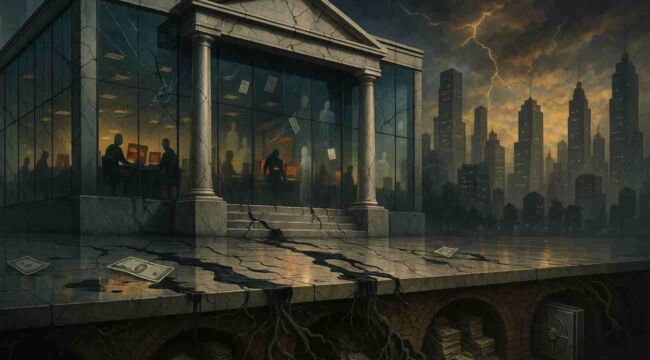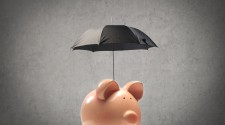The Bezzel: Is it 1925 All Over Again?
During a conference call with investors last week, JPMorgan CEO Jamie Dimon made a memorable response to a question from Wells Fargo analyst Mike Mayo about the collapse of a subprime auto lender called Tricolor that cost the bank $170 million. Tricolor went bankrupt due to allegations of fraud, including double-pledging of collateral, which led lenders to halt financing.
“Mike, you should assume that whenever something like that happens, we scour all process, all procedures, all underwriting, all everything, and we think we’re okay in other stuff,” said Dimon. “But I – my antenna goes up when things like that happen. And I probably shouldn’t say this, but when you see one cockroach, there are probably more.”
Dimon’s instinct about there being more big credit problems lurking beneath the surface of the US economy is correct, but even he may not fully appreciate the scale of the threat. The collapse of auto parts maker First Brands has revealed an enormous fraud at the center of the $2 trillion market for leveraged loans. Based on losses reported so far and the numerous acts of fraud emerging, half of the leverage loan market may end up being lost to investors.
There are a growing number of examples of malinvestment in the US economy, but much of it springs from excessive liquidity supplied by the Federal Open Market Committee. Since 2008 and particularly since COVID in 2020, the Fed did too much. While classical economic theory states that reserves at the central bank do not impact prices, in fact we can see that the “ample reserve” policy first adopted by the Fed under Chairman Ben Bernanke fueled a massive increase in fraudulent activity and inflation.
In a speech to the National Association of Business Economists, Fed Chairman Jerome Powell admitted that the Fed added too much liquidity to the economy after 2020. “With the clarity of hindsight, we could have—and perhaps should have—stopped asset purchases sooner,” said Powell. “Our real-time decisions were intended to serve as insurance against downside risks.” But the downside risk created by the FOMC is that mortgage delinquency may rise dramatically even as interest rates fall into 2026.
Even as the Trump Administration looks for ways to boost housing, this by again lowering interest rates, there are troubling signs of both inflation and deflation in the residential sector. In blue states, home prices continue to rise because of a dearth of new home construction. In red states that are more attractive for home builders, however, over supply is starting to force prices down from Florida to Texas. Lower interest rates may slow the home price correction, but we anticipate a significant drop in home values by 2028.
But beyond the housing market, the low-interest rate environment created by the FOMC has spawned an epidemic of fraud throughout the public and private credit markets. When we say private credit, we don’t refer only to the subprime assets being peddled to retail investors by the major Wall Street firms, but Main Street kind of fraud. The vast waves of liquidity provided by the Fed provided a ready environment for all types of commonplace swindles to proliferate.
“Gerald Marcil, a Los Angeles landlord and Republican donor, is among investors accused by Zions Bancorporation and Western Alliance Bancorporation of manipulating loan structures, leading to nearly $160 million in alleged losses for the banks,”reports The Real Deal, an invaluable publication that covers the national real estate market. Space does not permit us to tell you the full story of this all too typical California saga of bait and switch in commercial real estate.
Meanwhile, the CEO of Jefferies & Co, lead banker for First Brands, said that his bank likewise had been the victim of deception. Chief executive Rich Handler insists that the unravelling of First Brands, which could involve tens of billions in losses to investors, had not inflicted significant damage on the bank’s core business. Jefferies sold most of the debt raised for First Brands to investors. These victims of fraud will now look to the investment house for reparations.
The tales of woe regarding the Fed-fueled credit boom in commercial real estate and private credit will continue to grow in number, but it is important to point out that the relatively high-interest rates that prevailed in the US since 2022 have not prevented massive stock bubbles in technology stocks involved in “artificial intelligence” or AI, the latest marketing scam concocted by Wall Street to drive commissions.
Most of the private ventures formed around creating large language models to implement AI, for example, will never be profitable. An August 2025 MIT study found that 95% of AI projects within companies fail to deliver a positive return on investment or significant profit gains. The investment bankers will profit, however, proving yet again that the pages of the calendar may change, but human nature does not.
In the classic book, The Great Crash 1929, John Kenneth Galbraith argued that the crash revealed widespread financial misconduct, including embezzlement and other forms of bad behavior that had gone unnoticed during the preceding boom. The Roaring Twenties was an era characterized by rampant speculation in stocks and Florida real estate, which created an environment where it was difficult to distinguish between legitimate and fraudulent activity.
The Florida land boom crashed in 1926, primarily due to a combination of over-speculation, a credit crunch, and devastating hurricanes that year and in 1928. Even Charles Ponzi, whose eponymous scheme collapsed in 1920, later was involved in the Florida land business and was one of many swindlers whose scams were exposed. Florida real estate prices did not recover from the Great Depression until the 1970s. And here we are a century later, with Florida real estate prices starting to weaken.
Significantly Galbraith also described a form of fraud he called “the bezzle,” where fraud and theft are hidden, with the discovery of the crime only occurring after the passage of time. Galbraith explained that the speculative excess of the era created an illusion of wealth that made it difficult to distinguish between genuine and dishonest activity. In a 1929 article titled “Everybody Ought to Be Rich,” businessman John J. Raskob promoted the idea that anyone who invested a small amount each month could become wealthy.
As the US moves into 2026, you can be pretty sure that reports of losses to banks and nonbanks will multiply as the Roaring Twenties of the 21st Century grind to a close. Major Wall Street firms from JPMorgan to Goldman Sachs to Jefferies have already reported lapses in credit management and due diligence, the result of an era where bankers feel entitled to a certain level of wealth and are not particularly bothered about how they get it. But how big is the bezzel in the 21st Century?
Editor’s note: Learn more about Christopher Whalen at his website. Also be sure to check out his latest book, Inflated: Money, Debt, and the American Dream.



Comments: